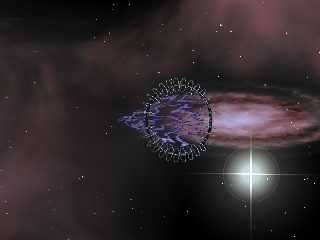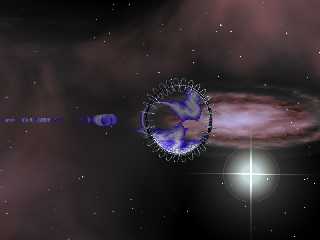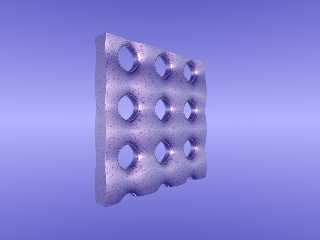 |
 |
|
 |
|
 |
|  |
|  |
|
 |
|
 |
|  |
|  |
|
 |
Just for the hell of it, I challenged myself to make a reasonably good image
inside of 15 minutes, including rendering.
This is what I came up with, total time 13min 12sec.
It's some sort of jump-gate thingy.
Considering that I am not very good at this, I don't think I did too badly.
Thanks to Chris Colefax for the Galaxy include,
and to Keith Hull for the Moray Plugin to use it.
NoOne
Post a reply to this message
Attachments:
Download '15min.jpg' (69 KB)
Preview of image '15min.jpg'

|
 |
|  |
|  |
|
 |
|
 |
|  |
|  |
|
 |
I think it would be really cool to use a hyperbolic conic section
instead of a cone for the "wormhole" effect.
Try using a quartic is oriented along the z-axis. It has maximum
radius Rmax and a minimum radius at z = -Infinity of Rmin. Making Zmin
approach 0 makes the "bell" shape look more like a flat plate with a
tiny wormhole, and making it bigger makes a wormhole that is more like a
gently tapering tube.
I hope this works for you!
Ben
<><
/*****************************************************************/
#declare Zmin = 4.0;
#declare Rmin = 0.2;
#declare Rmax = 2.0;
#declare Hfactor = (Rmax*Rmax - Rmin*Rmin) * Zmin*Zmin;
#declare xxzz = 1;
#declare yyzz = 1;
#declare zz = -Rmin*Rmin;
#declare const = -Hfactor;
quartic{
< 0, 0, 0, 0, 0, 0, 0,
xxzz, 0, 0, 0, 0, 0, 0,
0, 0, 0, 0, 0, 0, 0,
0, 0, yyzz, 0, 0, 0, 0,
0, 0, 0, 0, zz, 0, const >
sturm
translate<0,0,Zmin>
bounded_by { cylinder{<0,0,Zmin>,<0,0,-100-Zmin>,Rmax } }
clipped_by { bounded_by }
texture{ MyTexture }
}
Post a reply to this message
|
 |
|  |
|  |
|
 |
|
 |
|  |
|  |
|
 |
"Ben Birdsey" <cla### [at] mail com> wrote in message
news:3A0A0986.10DA189E@mail.com...
>
> I think it would be really cool to use a hyperbolic conic section
> instead of a cone for the "wormhole" effect.
>
> Try using a quartic is oriented along the z-axis. It has maximum
> radius Rmax and a minimum radius at z = -Infinity of Rmin. Making Zmin
> approach 0 makes the "bell" shape look more like a flat plate with a
> tiny wormhole, and making it bigger makes a wormhole that is more like a
> gently tapering tube.
>
> I hope this works for you!
>
> Ben
I used your idea and it looks much better now.
Thank you.
NoOne com> wrote in message
news:3A0A0986.10DA189E@mail.com...
>
> I think it would be really cool to use a hyperbolic conic section
> instead of a cone for the "wormhole" effect.
>
> Try using a quartic is oriented along the z-axis. It has maximum
> radius Rmax and a minimum radius at z = -Infinity of Rmin. Making Zmin
> approach 0 makes the "bell" shape look more like a flat plate with a
> tiny wormhole, and making it bigger makes a wormhole that is more like a
> gently tapering tube.
>
> I hope this works for you!
>
> Ben
I used your idea and it looks much better now.
Thank you.
NoOne
Post a reply to this message
Attachments:
Download '15min_a.jpg' (68 KB)
Preview of image '15min_a.jpg'

|
 |
|  |
|  |
|
 |
|
 |
|  |
|  |
|
 |
In article <3A0A0986.10DA189E@mail.com>, Ben Birdsey
<cla### [at] mail com> wrote:
> Try using a quartic is oriented along the z-axis.
I prefer isosurfaces myself, though they currently require a patched
version of POV. I mean, which is easier? This:
quartic{
< 0, 0, 0, 0, 0, 0, 0,
xxzz, 0, 0, 0, 0, 0, 0,
0, 0, 0, 0, 0, 0, 0,
0, 0, yyzz, 0, 0, 0, 0,
0, 0, 0, 0, zz, 0, const >
...
or this:(Not exactly the same as your function, but it should give you
the general idea)
isosurface {
function {z - 1/sqrt(sqr(x) + sqr(y) + 0.01)}
threshold 0
...
--
Christopher James Huff
Personal: chr### [at] mac com> wrote:
> Try using a quartic is oriented along the z-axis.
I prefer isosurfaces myself, though they currently require a patched
version of POV. I mean, which is easier? This:
quartic{
< 0, 0, 0, 0, 0, 0, 0,
xxzz, 0, 0, 0, 0, 0, 0,
0, 0, 0, 0, 0, 0, 0,
0, 0, yyzz, 0, 0, 0, 0,
0, 0, 0, 0, zz, 0, const >
...
or this:(Not exactly the same as your function, but it should give you
the general idea)
isosurface {
function {z - 1/sqrt(sqr(x) + sqr(y) + 0.01)}
threshold 0
...
--
Christopher James Huff
Personal: chr### [at] mac com, http://homepage.mac.com/chrishuff/
TAG: chr### [at] tag com, http://homepage.mac.com/chrishuff/
TAG: chr### [at] tag povray povray org, http://tag.povray.org/
<>< org, http://tag.povray.org/
<><
Post a reply to this message
|
 |
|  |
|  |
|
 |
|
 |
|  |
|  |
|
 |
Unfortunately for many, who are not math inclined, even to this extent,
the first is easier.
Chris Huff wrote:
> In article <3A0A0986.10DA189E@mail.com>, Ben Birdsey
> <cla### [at] mail com> wrote:
>
> > Try using a quartic is oriented along the z-axis.
>
> I prefer isosurfaces myself, though they currently require a patched
> version of POV. I mean, which is easier? This:
>
> quartic{
> < 0, 0, 0, 0, 0, 0, 0,
> xxzz, 0, 0, 0, 0, 0, 0,
> 0, 0, 0, 0, 0, 0, 0,
> 0, 0, yyzz, 0, 0, 0, 0,
> 0, 0, 0, 0, zz, 0, const >
> ...
>
> or this:(Not exactly the same as your function, but it should give you
> the general idea)
> isosurface {
> function {z - 1/sqrt(sqr(x) + sqr(y) + 0.01)}
> threshold 0
> ...
>
> --
> Christopher James Huff
> Personal: chr### [at] mac com> wrote:
>
> > Try using a quartic is oriented along the z-axis.
>
> I prefer isosurfaces myself, though they currently require a patched
> version of POV. I mean, which is easier? This:
>
> quartic{
> < 0, 0, 0, 0, 0, 0, 0,
> xxzz, 0, 0, 0, 0, 0, 0,
> 0, 0, 0, 0, 0, 0, 0,
> 0, 0, yyzz, 0, 0, 0, 0,
> 0, 0, 0, 0, zz, 0, const >
> ...
>
> or this:(Not exactly the same as your function, but it should give you
> the general idea)
> isosurface {
> function {z - 1/sqrt(sqr(x) + sqr(y) + 0.01)}
> threshold 0
> ...
>
> --
> Christopher James Huff
> Personal: chr### [at] mac com, http://homepage.mac.com/chrishuff/
> TAG: chr### [at] tag com, http://homepage.mac.com/chrishuff/
> TAG: chr### [at] tag povray povray org, http://tag.povray.org/
>
> <>< org, http://tag.povray.org/
>
> <><
Post a reply to this message
|
 |
|  |
|  |
|
 |
|
 |
|  |
|  |
|
 |
In article <3A0B4D28.4D5F9D05@home.com>, Thomas Lake <tla### [at] home com>
wrote:
> Unfortunately for many, who are not math inclined, even to this extent,
> the first is easier.
I thought the isosurface would be easier for everyone, but *especially*
for those who aren't "math inclined". (I certainly wouldn't describe
myself as being very good at math...) An equation has to be less
intimidating than a huge vector of numbers with no obvious relation
between them. It is certainly easier to type. :-)
I never have fully understood the poly object family. I know the basic
idea behind them, but have never used them and can't "see" them like I
can an isosurface.
Anyway, other advantages of isosurfaces are speed and flexibility(you
can do things that are impossible with polys, like noise and trig
functions).
--
Christopher James Huff
Personal: chr### [at] mac com>
wrote:
> Unfortunately for many, who are not math inclined, even to this extent,
> the first is easier.
I thought the isosurface would be easier for everyone, but *especially*
for those who aren't "math inclined". (I certainly wouldn't describe
myself as being very good at math...) An equation has to be less
intimidating than a huge vector of numbers with no obvious relation
between them. It is certainly easier to type. :-)
I never have fully understood the poly object family. I know the basic
idea behind them, but have never used them and can't "see" them like I
can an isosurface.
Anyway, other advantages of isosurfaces are speed and flexibility(you
can do things that are impossible with polys, like noise and trig
functions).
--
Christopher James Huff
Personal: chr### [at] mac com, http://homepage.mac.com/chrishuff/
TAG: chr### [at] tag com, http://homepage.mac.com/chrishuff/
TAG: chr### [at] tag povray povray org, http://tag.povray.org/
<>< org, http://tag.povray.org/
<><
Post a reply to this message
|
 |
|  |
|  |
|
 |
|
 |
|  |
|  |
|
 |
Honestly, I didn't think of using an isosurface. Even though the
functions are simpler for a POV programmer to write down, isosurfaces
are inherently slower to render than the "more efficiently coded" poly
objects .
I mean there is a large amount of overhead in just evaluating the math
expressions using an interpreter, not to mention poor renderings due to
max_gradient issues. (Check out the 1/r factor, which will cause the
gradient to blow up close to the z-axis).
But in this case I think you're totally right. Max gradient isn't an
issue and the increased time probably isn't a factor.
Ben
<><
Post a reply to this message
|
 |
|  |
|  |
|
 |
|
 |
|  |
|  |
|
 |
In article <3A0C8739.41D7D59C@mail.com>, Ben Birdsey
<cla### [at] mail com> wrote:
> Even though the functions are simpler for a POV programmer to write
> down, isosurfaces are inherently slower to render than the "more
> efficiently coded" poly objects.
Did you actually try it? Isosurfaces can often be faster than "hard
coded" objects, superellipsoids for example. It is probably dependant on
which poly object you are using, though...
> ...not to mention poor renderings due to max_gradient issues. (Check
> out the 1/r factor, which will cause the gradient to blow up close to
> the z-axis).
I used a slightly different function (more like 1/(r+n)) to avoid the
1/0 and extremely high gradient at the z axis. Otherwise, there was an
artifact going along the z axis. Once I fixed that, I didn't see
anything wrong with the render.
--
Christopher James Huff
Personal: chr### [at] mac com> wrote:
> Even though the functions are simpler for a POV programmer to write
> down, isosurfaces are inherently slower to render than the "more
> efficiently coded" poly objects.
Did you actually try it? Isosurfaces can often be faster than "hard
coded" objects, superellipsoids for example. It is probably dependant on
which poly object you are using, though...
> ...not to mention poor renderings due to max_gradient issues. (Check
> out the 1/r factor, which will cause the gradient to blow up close to
> the z-axis).
I used a slightly different function (more like 1/(r+n)) to avoid the
1/0 and extremely high gradient at the z axis. Otherwise, there was an
artifact going along the z axis. Once I fixed that, I didn't see
anything wrong with the render.
--
Christopher James Huff
Personal: chr### [at] mac com, http://homepage.mac.com/chrishuff/
TAG: chr### [at] tag com, http://homepage.mac.com/chrishuff/
TAG: chr### [at] tag povray povray org, http://tag.povray.org/
<>< org, http://tag.povray.org/
<><
Post a reply to this message
|
 |
|  |
|  |
|
 |
|
 |
|  |
|  |
|
 |
After reading all the comments and posts I realized I need to brush up on my
math, (I've always had the sneaking suspicion that everyone on this
newsgroup is smarter than I am) and I should have looked more closely at
isosurfaces when I got MegaPov. I origonally got it just for the photon
mapping.
I have been hunting for tutorials on isosurfaces since and have found a good
one by Samuel T. Benge at
http://www.hamiltonite.pwp.blueyonder.co.uk/raytracing/STBenge/stbenge.html
Thanks all
NoOne
P.S. my first isosurface.
Post a reply to this message
Attachments:
Download 'isso.jpg' (51 KB)
Preview of image 'isso.jpg'

|
 |
|  |
|  |
|
 |
|
 |
|  |
|  |
|
 |
On Fri, 10 Nov 2000 19:05:58 -0500, NoOne wrote:
>After reading all the comments and posts I realized I need to brush up on my
>math, (I've always had the sneaking suspicion that everyone on this
>newsgroup is smarter than I am) and I should have looked more closely at
>isosurfaces when I got MegaPov. I origonally got it just for the photon
>mapping.
>I have been hunting for tutorials on isosurfaces since and have found a good
>one by Samuel T. Benge at
>http://www.hamiltonite.pwp.blueyonder.co.uk/raytracing/STBenge/stbenge.html
[image]
Don't know what it is but it looks good.
--
Cheers
Steve email mailto:ste### [at] zeropps uklinux uklinux net
%HAV-A-NICEDAY Error not enough coffee 0 pps.
web http://www.zeropps.uklinux.net/
or http://start.at/zero-pps
1:16am up 31 days, 3:38, 2 users, load average: 1.07, 1.05, 1.02 net
%HAV-A-NICEDAY Error not enough coffee 0 pps.
web http://www.zeropps.uklinux.net/
or http://start.at/zero-pps
1:16am up 31 days, 3:38, 2 users, load average: 1.07, 1.05, 1.02
Post a reply to this message
|
 |
|  |
|  |
|
 |
|
 |
|  |
|
 |




![]()